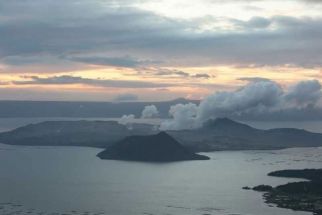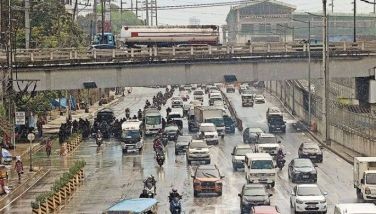Strong quake rattles Davao region

ZAMBOANGA CITY , Philippines — A strong earthquake of magnitude 7.10 struck off Davao Oriental yesterday, triggering a tsunami alert that was recalled some two hours later.
An Intensity 2 aftershock was reported later yesterday at 5:13 p.m. or almost six hours after the 11:39 a.m. earthquake.
Philippine Institute of Volcanology and Seismology (Phivolcs) regional monitoring officer Allan Rommel Labayog said preliminary plotting indicated the tremor occurred at some 162 kilometers southeast of Governor Generoso town in Davao Oriental.
The United States Geological Survey (USGS) said the earthquake struck 193 kilometers east of General Santos City, at a depth of 60 kms. Labayog said the quake was at the depth of 49 kms and felt mostly in the Davao provinces but even as far as Sulu.
The USGS initially said the magnitude of the quake was 7.2 but later downgraded it to 6.9. There were no reports of casualties or damage from the earthquake.
Labayog said the earthquake was triggered by a tectonic movement near the Philippine Trench.
The Pacific Tsunami Warning Center initially said “hazardous tsunami waves were possible within 300 km of the epicenter,” along the coasts of the Philippines, Indonesia and the Pacific island nation of Palau.
About two hours after the quake struck, the center said there was no longer a tsunami threat.
The earthquake reportedly lasted about a minute and people rushed out of buildings but there was no major damage.
“I was at the front desk and saw the chandeliers swaying,” Jonna Ramos, who works at the Anchor Hotel in General Santos City, told Reuters by telephone, adding that all guests and staff had left the building but later went back in.
Indonesian media also said there were no reports of damage.
The Philippines and Indonesia are both on the Pacific “Ring of Fire,” a horse-shoe shaped band of volcanoes and fault lines circling the edges of the Pacific Ocean.
Indonesia had been struck by two serious tsunamis this year.
The first followed a 7.5 magnitude quake on the west coast of Sulawesi island in September. More than 2,000 people were killed.
The second tsunami struck a week ago, on Saturday evening, when part of a volcanic island collapsed in the Sunda Strait, between Java and Sumatra islands, generating tsunami waves that killed more than 400 people.
In the Philippines, Labayog said intensity 5 was felt in the areas of Gov. Generoso, Davao Oriental, Glan Sarangani, Koronadal City; intensity 4 in the cities of Kidapawan, General Santos, Tupi town in South Cotabato, Kiamba in Sarangani, Mati City, Manay town, Davao Oriental and Davao City.
Intensity 3 was felt in Makilala town, North Cotabato, Valencia City, Manolo Fortich in Bukidnon, Cagayan de Oro City, Maitum town, Sarangani, Tagum City, Mabini in Compostela, Tacloban City and Palo in Leyte.
Intensity 2 tremor rocked areas in Surigao City, Kadinglan and Don Carlos, Bukidnon, Tagoloan and El Salvador City in Misamis Oriental, M’lang town of North Cotabato, Surallah, South Cotabato. In Zamboanga City, the quake was felt at intensity 1.
He said the Phivolcs national center immediately raised warning of minor sea level disturbances, including strong currents.
“The concerned public is advised to be on alert for unusual waves,” Labayog said, quoting an earlier Phivolcs advisory.
The advisory indicated that based on the tsunami models and early tide gauge records of tsunami in the Philippine Sea, coastal areas are expected to experience waves of less than one meter above the normal tide levels.
It was initially stated in the Phivolcs advisory that the first tsunami waves – not the largest – would arrive between noon and 2 p.m yesterday.
Phivolcs had also advised people to stay away from the beach until the threat of tsunami was over.
The advisory also called on those living near the shoreline of affected areas to move farther inland while owners of boats in harbors, estuaries or shallow coastal waters were told to secure their vessels. – Rhodina Villanueva, Jaime Laude
- Latest
- Trending




























